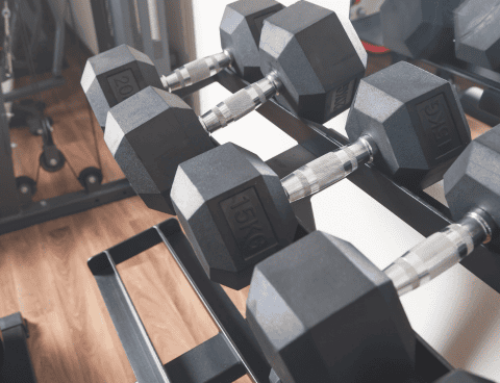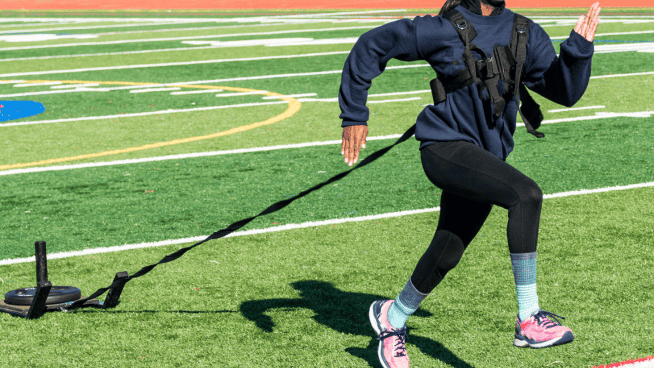The Right Approach to In-Season Weightlifting for High School Football Players
High school football players can recover from training very quickly because they are young, their hormone levels are high, and their growing muscles and tissues are resilient. Still, most high school athletes are being overtrained. Typically a coach will have players running drills and tackling one another with pads anywhere from two to three hours a day, multiple times a week. Then they hit the weight room four days a week.
For high school players during the season, it’s better to scale down to two days of lifting per week and incorporate speed work into their conditioning at the end of practice. (For conditioning drills that also help with speed development, see my football conditioning article.)
Here is a weightlifting program I’ve designed for high school football players. I recommend a Monday/Wednesday training split to give one day off between workouts and one day between Wednesday’s workout and Friday’s game.
Be sure to follow all aspects of this routine—especially the foam rolling, mobility and dynamic warm-up—to ensure your athletes receive the full benefits.
Warm-Up
I cannot stress this enough: The warm-up is the most important part of the workout. To improve their performance, athletes need to properly prepare their bodies for the work they are about to do.
This is just an example of what you can do, not what you are limited to doing.
Foam Roll
- Calves
- Hamstrings
- Hips
- IT Bands
- Quads
Mobility
- Bird Dogs
- Fire Hydrants
- Fire-Hydrant Circles
- T-Spine Rotations
- Roll Back to V Sit
- Scorpions
Dynamic Warm-Up
- Arm Circles Forward and Back
- Jumping Jacks
- Trunk Rotations
- Walking Lunge with Knee Lift
- Side Lunges
- Inch Worms
Workout
After the warm-up, proceed to the workout. Below is a general template of exercise types and sequence. Choose what works for you and your team based on the tools you have, but this outline will help you stay on the right track.
Important: Pair (A) and (B) exercises together in a superset. For example, 5A and 5B: do a set of Vertical Pushes and immediately follow it with a set of Vertical Pulls.
- 1. Jumping/Plyometrics, 6-8 sets of 1-3 reps
- 2. Olympic Lift Variation, 3-5 sets of 2-3 reps
- 3A. Horizontal Push, 3 sets of 3-8 reps
- 3B. Horizontal Pull, 3 sets of 6-12 reps
- 4A. Knee -Dominant Leg Exercise (Monday); Hip-Dominant Leg Exercise (Wednesday), 3 sets of 3-8 reps
- 4B. Core, 3 sets of 20-25 reps
- 5A. Vertical Push, 3 sets of 3-8 reps
- 5B. Vertical Pull, 3 sets of 3-8 reps
- 6. Heavy Carry, for distance or time
Read more:
- Get Better Throughout the Season With These In-Season Football Workouts
- Maryland Football’s In-Season Strength Workout
- Leave These Exercises Out of In-Season Football Strength Workouts
Photo: vikeswtst.com
RECOMMENDED FOR YOU
MOST POPULAR
The Right Approach to In-Season Weightlifting for High School Football Players
High school football players can recover from training very quickly because they are young, their hormone levels are high, and their growing muscles and tissues are resilient. Still, most high school athletes are being overtrained. Typically a coach will have players running drills and tackling one another with pads anywhere from two to three hours a day, multiple times a week. Then they hit the weight room four days a week.
For high school players during the season, it’s better to scale down to two days of lifting per week and incorporate speed work into their conditioning at the end of practice. (For conditioning drills that also help with speed development, see my football conditioning article.)
Here is a weightlifting program I’ve designed for high school football players. I recommend a Monday/Wednesday training split to give one day off between workouts and one day between Wednesday’s workout and Friday’s game.
Be sure to follow all aspects of this routine—especially the foam rolling, mobility and dynamic warm-up—to ensure your athletes receive the full benefits.
Warm-Up
I cannot stress this enough: The warm-up is the most important part of the workout. To improve their performance, athletes need to properly prepare their bodies for the work they are about to do.
This is just an example of what you can do, not what you are limited to doing.
Foam Roll
- Calves
- Hamstrings
- Hips
- IT Bands
- Quads
Mobility
- Bird Dogs
- Fire Hydrants
- Fire-Hydrant Circles
- T-Spine Rotations
- Roll Back to V Sit
- Scorpions
Dynamic Warm-Up
- Arm Circles Forward and Back
- Jumping Jacks
- Trunk Rotations
- Walking Lunge with Knee Lift
- Side Lunges
- Inch Worms
Workout
After the warm-up, proceed to the workout. Below is a general template of exercise types and sequence. Choose what works for you and your team based on the tools you have, but this outline will help you stay on the right track.
Important: Pair (A) and (B) exercises together in a superset. For example, 5A and 5B: do a set of Vertical Pushes and immediately follow it with a set of Vertical Pulls.
- 1. Jumping/Plyometrics, 6-8 sets of 1-3 reps
- 2. Olympic Lift Variation, 3-5 sets of 2-3 reps
- 3A. Horizontal Push, 3 sets of 3-8 reps
- 3B. Horizontal Pull, 3 sets of 6-12 reps
- 4A. Knee -Dominant Leg Exercise (Monday); Hip-Dominant Leg Exercise (Wednesday), 3 sets of 3-8 reps
- 4B. Core, 3 sets of 20-25 reps
- 5A. Vertical Push, 3 sets of 3-8 reps
- 5B. Vertical Pull, 3 sets of 3-8 reps
- 6. Heavy Carry, for distance or time
Read more:
- Get Better Throughout the Season With These In-Season Football Workouts
- Maryland Football’s In-Season Strength Workout
- Leave These Exercises Out of In-Season Football Strength Workouts
Photo: vikeswtst.com











